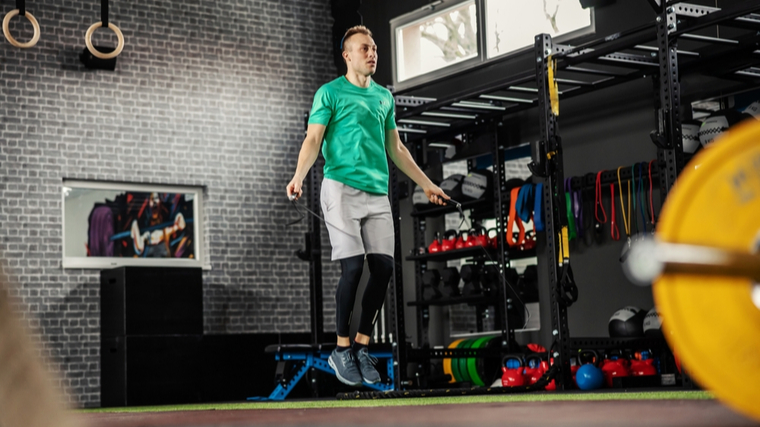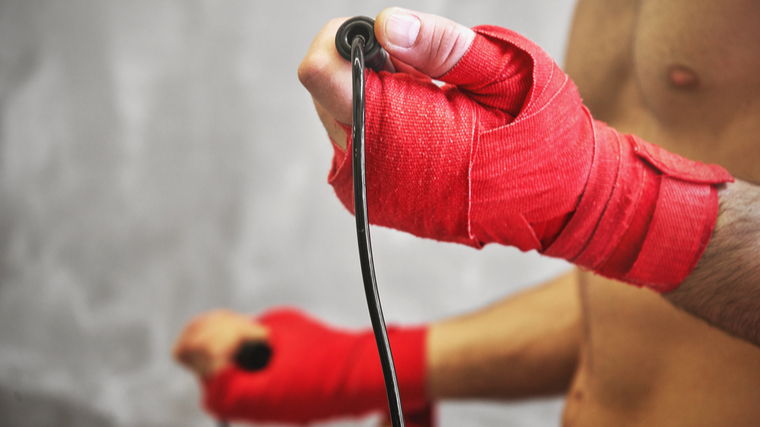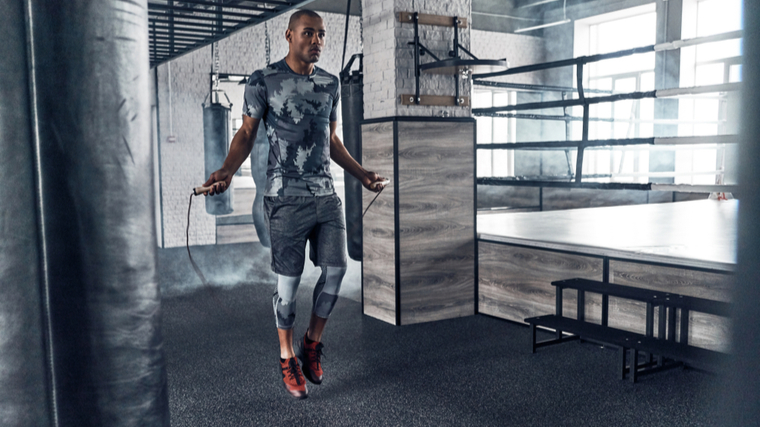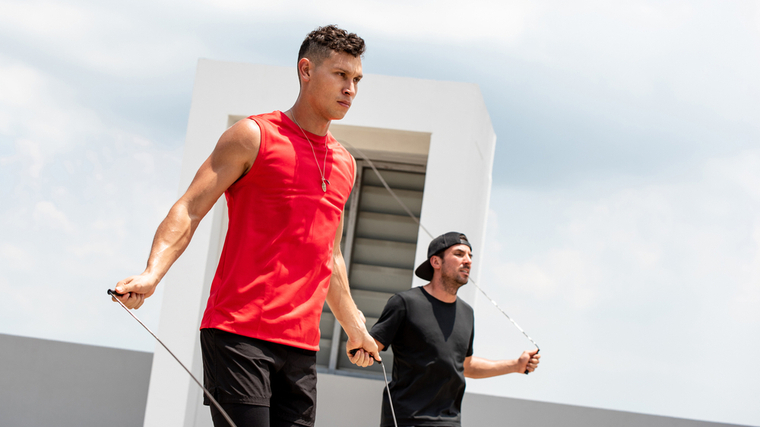The sound of a clacking jump rope might bring you back to the middle school playground or your childhood backyard. As an adult, though, you may not pick one up nearly as often — unless you’re a CrossFitter, that is. Double unders — also known as dubs — are a type of jump rope technique that requires the jump rope to pass under your feet twice per jump.
As simple as it sounds, double unders take a lot of coordination, proper timing, practice, and agility to get them down. Even for advanced athletes, double unders can spell frustration, fatigue, and a huge test of mental endurance.

You won’t want to skip this jump rope move in your program. You’ll improve your heart health, get stronger, challenge your mind, and even burn a boatload of calories if that’s one of your goals. All you need is a proper jump rope, some room, and a little bit of knowledge to get you started.
- How to Do the Double Under
- Double Under Sets and Reps
- Common Double Under Mistakes
- Double Under Variations
- Double Under Alternatives
- Muscles Worked by the Double Under
- Benefits of the Double Under
- Who Should Do the Double Under
- Frequently Asked Questions
Editor’s note: The content on BarBend is meant to be informative in nature, but it shouldn’t take the place of advice and/or supervision from a medical professional. The opinions and articles on this site are not intended for use as diagnosis, prevention, and/or treatment of health problems. Speak with your physician if you have any concerns.
How to Do the Double Under
Double unders are the type of exercise where it takes practice to get even one rep down. Knowing the tips and tricks to do them properly can help you master your first rep and fly through the rest.
Step 1 — Get the Proper Jump Rope

Find a jump rope that is the right height for you. To find this height, stand on the middle of the jump rope. Pull the handles up toward you. The handles should come to about the height of your chest.
Coach’s Tip: If you’re a beginner, you may want a slightly heavier rope so you can feel the rope moving around your body. More advanced athletes may want to stick with a lighter rope for more speed.
Step 2 — Set Your Hands and Elbows

Keep your elbows close to your body. Hold the handles at about a 45-degree angle. Keep this position when you start jumping. The farther your elbows are away from your body, the shorter the rope becomes. That means you have to use more effort to jump higher just to clear the rope.
Coach’s Tip: If your elbows tend to go wider, place yourself between two boxes positioned about four feet apart. The rope will hit the boxes if your elbows widen. This can teach you to keep your elbows in.
Step 3 — Start Jumping

Jump higher than you do with regular single unders. Aim to stay in the air slightly longer to allow the rope to pass under twice. Keep your body in a straight line as you jump and hop from the balls of your feet.
Coach’s Tip: Try practicing the jump without the rope. A drill called penguin hops can help train your body and mind for the proper timing. In this drill, you power jump straight up and down and slap your hands on your legs twice to simulate double under timing.
Double Under Sets and Reps
When you’re working with a jump rope, you’re not going to perform traditional sets and reps like you do with a barbell or dumbbells. Instead, you’ll likely be programming double unders into complex workouts for higher rep schemes.
- For Skill-Building: To master double unders, perform three singles, then one double under and repeat as smoothly as you can. Accumulate as much volume as you can without a mistake.
- For Endurance: Superset 50 double unders with 25 push-ups. Repeat for five rounds.
- For Mental Toughness: Perform an ascending rep ladder of 10-20-30-40-50 double unders, resting as little as possible in between.
Modify these reps schemes as needed to accommodate your skill level. For example, if you can’t quite pull off 50 double unders and 25 push-ups, lower the rep scheme with the same 2:1 ratio. Try 20 double unders with 10 push-ups, or even 10 double-unders with five push-ups instead. Build up from there.
Common Double Under Mistakes
When frustration and fatigue kicks in, it can be easy to make mistakes. Avoid these common mistakes to help you become a more successful jumper.
Losing Your Form
The timing and technique of double unders is different from single unders. You have to jump higher and learn to absorb the landing, so you can hope right into your next rep. This higher jump is also referred to as a power jump. It’s important not to pause before jumping again or else you might whip your legs with the rope.

If you can’t jump high enough, you may have a tendency to compensate by driving your knees toward your chest, driving your feet behind you like a donkey kick, or shifting into a pike. This can use way more energy per rep than keeping your body in a straight line. It can also limit a solid landing and rebound, making multiple reps of double unders even more difficult. Focus instead on gaining height instead of contorting your body.
Too Much Arms and Too Little Wrist
The secret to double unders is all in the wrist. Swinging your arms too much can cause you to lose control of the rope, making it difficult to do even one double under. Keeping your elbows close to your sides gives you more control. Quickly flick your wrists instead of sending your elbows out to increase the speed of the rope — and your efficiency.
Using the Wrong Rope
Whether it be the wrong length or the wrong material, not using the right rope for your height or double under level can be what’s holding you back. When you’re learning, it’s important to use the same rope consistently. This can help avoid unpredictable spinning speed or various lengths literally tripping you up. You can buy your own jump rope and take it to the gym, or you can try to snag the same gym rope each time.
Double Under Variations
So, you’ve mastered double unders. Now, you’re looking for a challenge. There are other ways to get work hard with a jump rope that might take a little more coordination.
Criss-Cross Double Unders
Make sure you’re a pro at mastering double unders before attempting this variation. Criss-cross double unders involve crossing your arms in front of your body for just one pass of the rope.
Within the same rep, you’ll uncross your arms, resetting to the standard position for the second pass. It requires extremely quick upper body movements and a lot of coordination.
Reverse Double Unders
This variation is what it sounds like — double unders, but in reverse. Although the movement and timing itself doesn’t change too much, flicking your wrists backwards instead of forwards may feel less natural and require more coordination.
With forward double unders, you’re performing a pushing motion. On the other hand, you’re pulling with reverse double unders.
Double Under Alternatives
Maybe you don’t have a jump rope, or you’re still getting double unders down. There are other alternatives to help you progress or reap similar benefits with different equipment.
Single Unders
The scaled version of double unders are single unders. Just like standard jump rope, the rope only passes under your feet once per rep. This doesn’t require as high of a jump or as much coordination. That makes this move a bit more accessible to new CrossFitters.
But the rope only passing under you once doesn’t make this move easy. You do still need speed and stamina to keep these up for a long time. Singles get your heart pumping and use the same muscle groups as doubles.
Three Singles, One Double
To master double unders, you need to practice. Instead of constantly whipping yourself trying to get that first rep, try a drill to help with the timing. Perform three singles, then one double.
This can help train your body to keep moving after that first rep. Practicing the power jump during the three singles can improve your jump height and timing.
Box Jumps
Don’t have a jump rope? Maybe you can get your hands — or feet — on a plyo box. Double unders take a little more coordination than box jumps, but they use similar muscles to propel you off the ground.
You rely on the power from your lower body to drive up onto the box. This will help improve your jumping height for the power jump in double unders. Like double unders, box jumps will help you build lower body strength and kick up your cardio training.
Muscles Worked by the Double Under
You can get a full-body session with double unders, as they work many of the major muscle groups. Here are their primary movers.
Calves
After just a few reps of double unders, you know all too well how much they make your calves burn. This muscle group is responsible for flexing your ankles and feet and is engaged during running or jumping movements. Staying on the balls of your feet as you bounce up and down keeps your calves engaged, while propelling you into the next rep.
Quadriceps
Anytime you kick, run, or jump, your quads are involved. One of the main functions of your quads is to help extend your knees. They’re hard at work as you jump straight up and down in double unders. Strengthening this muscle group is key for squatting heavier, staying stabilized, and moving more efficiently in general.
Hamstrings
Your hamstrings help to extend your hips. Part of their role in double unders is to keeping your hips from flexing back into a pike position. Without strong hamstrings, your knees may not be as stable, and your ACL may be at a higher risk of injury. (1) This muscle group helps produce the force you need to jump higher, but it also can play a role in landing properly and safely.
Glutes
One of the biggest and strongest muscles in your body are behind you — your glutes. They’re responsible for helping stabilize and extending your hips. Strong glutes help you achieve that higher jump in double unders. If you want to get better at these, glute strengthening exercises like lunges and hip thrusts can contribute to a more powerful jump. (2)
Abdominals
Your core helps stabilize your body and contributes to better balance. When you’re jumping up and down, your abdominal muscles help to transfer the force from your upper body to your lower body, making your jump better and more efficient.
Core stability training is known to help produce higher jumps, so don’t forget to hold your planks and do your crunches to help with your double unders. (3)
Forearms
After a long bout of double unders, you may be feeling some soreness in your forearms and wonder if you did something wrong. Although jumping rope might just seem like a lower body endeavor, your forearms are working hard to grip the jump rope and flick your wrists.
There’s not a way to completely eliminate forearm fatigue during double unders, but you can help by implementing grip strength exercises like the farmer’s carry into your routine.
Shoulders
As you swing the jump rope, you recruit your shoulders are recruited to help in the action. They help to stabilize your upper body and keep control of the rope, all the while maintaining an upright position needed for better double unders.
Overhead athletes like volleyball players or weightlifters can benefit from a jump rope routine because of its ability to build shoulder strength. (4)
Benefits of the Double Under
Your whole body is working when you’re jumping rope, but that’s not the only thing you can get out of it.
Better Heart Health
Double unders are a full-body workout that helps strengthen many of the major muscle groups of your body — including your heart. Grabbing a jump rope can be a great alternative to running on the treadmill or biking on the Peloton because it can increase your heart rate quickly and efficiently, contributing to overall better heart health.

[Read More: Our Favorite Forearm Workouts, + the Best Forearm Exercises]
Jumping rope for just 10 minutes a day may provide the same cardiovascular benefits as jogging for 30 minutes a day. (5) One reason for this is that jumping rope at a high intensity can use nearly twice as much energy as jogging for the same amount of time. (6)
Improved Balance and Coordination
Whether you’re throwing down on the court or just walking down the street, balance and coordination are key for efficient movement and keeping you upright. Enter double unders as a way to boost your coordination and balance.
You need a whole lot of balance during the landing and rebound phase, as you need to land and bounce quickly right into the next rep. As for coordination, how else will you get your wrists and lower body to keep time with each other so precisely and quickly? Practicing and perfecting the rope swing while getting the timing right is a crucial — and fun — way to improve the way you move in and outside the gym. (7)
It’s Relatively Low Impact
Those with joint issues or achy knees may not do well with running activities. Overuse injuries in the back and legs are commonly associated with running, and 25 percent of runners are injured at any given time. (8)
You might be on the market for alternatives to jogging without the high impact or potential injury risk. Compared to running, jumping rope can have a lower impact on your ankles and knees, making double unders a potential alternative to running. (9)
Accessibility
You may not have access to fancy cardio equipment or have time to hit the gym everyday, but you can pick up a jump rope almost anywhere. From your living room to the break room at work, you can practice your double unders while getting your heart rate super high in just 10 minutes. You can find cheap jump ropes at almost any store, but if you’re serious about perfecting double unders, opt for a higher quality one.
Who Should Do the Double Under
Since jump ropes are easily accessible, just about anyone can train with them. Although CrossFitters can benefit from double unders, they’re not the only ones.
CrossFitters
Double unders are popular in CrossFit boxes, and you might see them frequently in the your daily metcon. Mastering double unders can help you perform a workout to its original specifications.
They are also great for conditioning and improving other areas in CrossFit like running, overhead lifts, and stamina through long workouts.
Ball Sports Athletes
One thing that sports like football, volleyball, and baseball have in common is the overhead strength that athletes need to throw or spike a ball. Double unders help build shoulder strength, which you need not only for throwing power, but for stabilizing your upper body and helping prevent potential injury.
Runners
As a runner, you need strength, power, endurance, and coordination to be successful. You may do a lot of running drills to practice these skills, but jumping rope could be just as beneficial, if not moreso. Jumping rope can help improve a runner’s speed, explosiveness, jumping ability, and arch stiffness compared to a standard running warm-up. (10)
Regular Gymgoers
A lot of gymgoers looking to improve their cardiovascular fitness and overall strength can benefit from double unders. Jumping rope is a great form of cardio, so if you’re tired of the treadmill, you can grab a rope instead. Since it can be lower impact, jumping rope makes for a great alternative to other higher impact exercises like running.
Start Jumping
Mastering double unders takes a hefty dose of practice and patience. Taking the time to do the double under drills and practice them in your CrossFit box or living room will help you progress even if the going is slow. Whenever you whip yourself in the leg or get the rope caught on your foot, don’t get discouraged. Keep skipping the rope, but don’t skip out on the practice.
FAQs
Double unders are harder than they look, and you might only come to realize it when you first pick up that jump rope. You might have some questions, so here are some frequently asked ones.
How often should I practice double unders?
Anything good comes with time, and that’s especially applied to double unders. Practicing them for 10 minutes each day can help beginners get them down quickly. It’s important to remember that everyone learns and moves at their own pace, so don’t expect to be a pro overnight. Warm-up with double unders for a few minutes before each workout or practice them while watching your favorite TV show.
How do I jump higher?
The power jump not only comes from your lower body, but also from your abdominals. To achieve a more powerful jump, you’ll want to strengthen the muscles that help in the movement. Calf raises, squats, and deadlifts are just a few of the exercises that can help contribute to a stronger lower body and core. Practicing plyometrics like box jumps or jump squats can also help improve your jumping power.
Can anyone do double unders?
Although double unders can be accessible to many athletes, not everyone should be doing them. People with existing injuries to the legs, knees, or feet — for example, people prone to plantar fasciitis — may want to avoid jumping exercises like double unders. It’s important to consult with a doctor first to check in about what your limitations might be.
References
- Yanagawa, Takashi, Shelburne, Kevin, & Serpas, Frank. Effect of hamstrings muscle action on stability of the ACL-deficient knee in isokinetic extension exercise. Clinical Biomechanics. 2002; 17(9-10). doi: 10.1016/s0268-0033(02)00104-3
- Gallego-Izquierdo, Tomas, Vidal-Aragon, Gerardo, & Calderon-Corrales, Pedro. Effects of a Gluteal Muscles Specific Exercise Program on the Vertical Jump. International Journal of Environmental Research and Public Health. 2020; 17(15). DOI:10.3390/ijerph17155383
- Sannicandro, I., Cofano, Giacomo. Core Stability Training and Jump Performance in Young Basketball Players. International Journal of Science and Research. 2017; 6(5). DOI:10.21275/ART20173282
- Duzgun, Irem, Baltaci, Gul, & Colakoglu, Filiz. The effects of jump-rope training on shoulder isokinetic strength in adolescent volleyball players. Journal of Sport Rehabilitation. 2010; 19(2). doi: 10.1123/jsr.19.2.184
- Baker, John A. Comparison of Rope Skipping and Jogging as Methods of Improving Cardiovascular Efficiency of College Men. American Association for Health, Physical Foundation and Recreation. 2013. 240. https://doi.org/10.1080/10671188.1968.10618043
- Tools & Calculators. American Council on Exercise. 2021. https://www.acefitness.org/resources/everyone/tools-calculators/physical-activity-calorie-counter/
- Trecroci, Athos, Cavaggioni, Luca, & Caccia, Riccardo. Jump Rope Training: Balance and Motor Coordination in Pasreadolescent Soccer Players. Journal of Sports Science and Medicine. 2015; 14(4).
- Kakouris, Nicolas, Yener, Numan, Fong, Daniel T.P. A systematic review of running-related musculoskeletal injuries in runners. Journal of Sport and Health Science. 2021; 10(5). https://doi.org/10.1016/j.jshs.2021.04.001
- McDonnell, Jessica, Willson, John D., & Zwetsloot, Kevin A. Gait biomechanics of skipping are substantially different than those of running. Journal of Biomechanics. 2017; 64(180). doi: 10.1016/j.jbiomech.2017.09.039
- Garcia-Pinillos, Felipe, Lago-Fuentes, Carlos, & Latorre-Roman, Pedro A. Jump-Rope Training: Improved 3-km Time-Trial Performance in Endurance Runners via Enhanced Lower-Limb Reactivity and Foot-Arch Stiffness. International Journal of Sports Physiology and Performance. 2020; 12(1). DOI: 10.1123/ijspp.2019-0529
Featured Image: Dusan Petkovic / Shutterstock